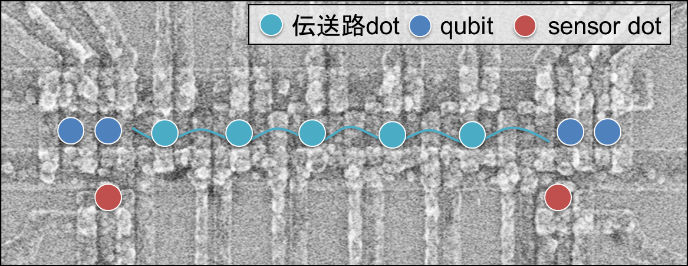Progress Report
Development of scalable Silicon quantum computer technology[2] Development of middle-distance quantum link
Progress until FY2024
1. Outline of the project
To realize large-scale quantum processors in the future, it is essential to flexibly connect distant spin-based quantum bits (qubits) within semiconductor platforms. In this Theme, we focus on developing "middle-distance coupling" technologies, which allow the transfer of quantum information over micrometer-scale distances. This capability enables scalable qubit integration across an entire chip, which is important towards fault-tolerant quantum computing.

2. Outcome so far
1. Exploring Various Qubit Transfer Methods
There are several ways to transfer qubits from one place to another: A "bucket brigade" method, where qubits are passed one-by-one by use of quantum tunneling. A "conveyor mode" method, where the potential landscape is shifted to carry the qubits smoothly. An exchange-interaction-based method that relays intermediate qubits to swap information.
We conducted small-scale simulations of the electromagnetic and quantum behavior of each method. Based on these studies, we identified the characteristics, challenges, and optimization approaches for each approach.
2. Testing Multi-Qubit Structures and Control Systems
To test the methods to couple qubits, we investigate quantum dots, tiny regions in a semiconductor that can hold single electrons, in a one-dimensional array serving as a “quantum link”.
Testing in-lab fabricated samples at low temperatures secured stable operation of electronic control systems that are essential for future quantum coupling demonstration.


3. Developing Devices for Conveyor Mode Method
Our analysis suggests that the conveyor mode method, using regularly spaced electrodes and periodic voltage signals, is a promising approach holding scalability and structural simplicity.
Challenges remain for us to ensure stable transfer of qubits over the quantum link without being excited. Solving them separates two qubits more distant required for realistic wiring technologies to facilitate operation of large-scale qubit processors.

3. Future plans
The outcomes of this theme provides us the ground for building future quantum processors. Requirement has been grown for developing a method to connect middle-distant two qubits in a fast and accurate way, that we can implement by a structure manufactured with today’s industrial technologies of device integration.